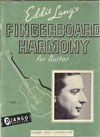Pros: Great introduction to early theory. Would give the student an exhaustive chord knowledge. 3 way approach works well.
Cons: Dated (come on, 1936)? Second section may be too much for the average student.
`The fact that this book is still available speaks volumes. It was published in1936! It is one of the first guitar books I ever bought, and I have my copy- tattered and worn- in front of me. Another point in its favour is that it was the book Julian Bream (don't know him- go to youtube and be amazed) learned his early harmony and theory from. Although I have diplomas and have taught harmony at tertiary level, I have had few lessons, and much of what I know and understand came from this book. The 3 way approach is used throughout, so whether you study on your own or with a teacher, eventually it will make sense. At the beginning of the book is a chart of the guitar fingerboard, which gives a representation of the fingerboard at the top with all note names filled in, and below the same thing in notation. I give it to all my students. I've seen this elsewhere, but this is the best so far.He goes on to explain basic music theory and, (despite the passage of years), this hasn't changed. There are lots of worthwhile exercises, better, in my view, than Royal Schools or Trinity (at least for guitarists). The next section investigates major, minor, dominant, diminished and augmented chords. Heavy going, but get through this lot and you will know your chords. Recommended for serious students.
Submitted by: Bruce on 08/26/2013 09:52:00 AM
 Default Manufacturer
Eddie Lang’s Fingerboard Harmony for Guitar documents Lang’s incredible fret board knowledge. It includes hundreds of examples of his chord shapes, fingerings, and reharmonization techniques. An invaluable resource for any guitarist, especially one trying to emulate Lang’s brilliant chordal work. This highly organized and well thought out book uses a teaching system that simultaneously incorporates the strengths of "eye-minded," "ear-minded," and "motor-minded" students . Includes chord diagrams and fingerings. 103 p.
Arts & Entertainment
lang_harmony
4008
4.0
1
Default Manufacturer
Eddie Lang’s Fingerboard Harmony for Guitar documents Lang’s incredible fret board knowledge. It includes hundreds of examples of his chord shapes, fingerings, and reharmonization techniques. An invaluable resource for any guitarist, especially one trying to emulate Lang’s brilliant chordal work. This highly organized and well thought out book uses a teaching system that simultaneously incorporates the strengths of "eye-minded," "ear-minded," and "motor-minded" students . Includes chord diagrams and fingerings. 103 p.
Arts & Entertainment
lang_harmony
4008
4.0
1









